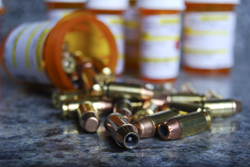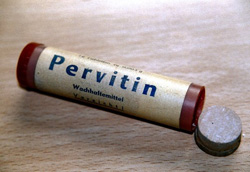By CCHR International
November 24, 2015
CNN, The Washington Post, The Boston Globe, The Independent, and hundreds of news outlets are now reporting that “The War on Drugs” has taken on a literal twist, with ISIS fighters being fueled by a stimulant drug known as Captagon—a pharmaceutical cousin of the ADHD drug, Adderall. Captagon is the trademark name for the stimulant fenethylline which contains amphetamine and also makes up 75% of the composition of Adderall.[1] It was used in the 1960s for the supposed treatment of “ADHD” before being banned in a number of countries. As The Boston Globe reports, Captagon is a “toxic fuel” that creates “super-human” fighters. The drug “quickly produces a euphoric intensity in users, allowing fighters to stay up for days, killing with a numb, reckless abandon.”[2]
And a November 21st article “Breaking Bad: The Stimulant Drugs That Link ISIS and the Nazis,” posted in Haaretz, the world’s leading English-language Website for news and analysis of the Middle East, points out, “ISIS is far from the first murderous group to drug its fighters before battle….The Persian Hashashin did it way back in the 11th century, as did Japanese kamikaze pilots, African militias, Chechen fighters and Nazi soldiers.”[3]
When French Special Forces officers raided the hotel room of wanted ISIS terrorist Salah Abdelsalam in the Paris suburb of Alfortville last week, Captagon was reportedly found, according to Haaretz news.[4] Like other amphetamines, it can cause euphoria, addiction, lowered inhibitions, and at higher doses, psychosis, paranoia, and violent aggression.[5]
-

Captagon was reportedly found in the hotel room of wanted ISIS terrorist Salah Abdelsalam in the Paris suburb of Alfortville last week when French Special Forces officers raided it.
The multimillion-dollar Captagon trade is a fixture of the Middle East’s black markets.[6] It sells illegally for $5-$20 a pill.[7]
- CNN said that one 19-year-old fighter named Kareem, who said he fought alongside ISIS for more than a year, said: “They gave us drugs, hallucinogenic pills that would make you go to battle not caring if you live or die.”[8]
- A former Free Syrian Army member said when an officer told fighters to take the drug for the first time, it “felt like if there were ten people in front of you, you could catch them and kill them.” [9]
- Two ISIS fighters caught in Turkey reported being given Captagon. One, Ali Daud, 23, told a local newspaper: “It makes us feel big, strong, as if looking at the battle from above. You think the tanks are little birds that you can destroy with your sword. We took the drug only when we went into battle, for maximum effect.”[10]
- Another described how “There was no fear anymore after I took Captagon.”[11]
-
As Haaretz reported, the issue of soldiers being drugged for battle is not uncommon: The German military was supplied with millions of methamphetamine tablets called Pervitin during WWII. The substance increased a willingness to take risks, while reducing sensitivity to pain, hunger, thirst and the need for sleep. In 1939, the drug was tested on 90 university students by a military doctor who concluded that Pervitin could help the Nazi armed forces to win the war.[12]
- In fact, it was the German pharmaceutical company Degussa AG that introduced fenethylline (Captagon) in 1961 as a treatment for ADHD and usage became prevalent across the world, according to George Washington University researchers in a May 2015 paper investigating Captagon trafficking by Syrian War Militias. [13]
- Degussa AG is infamous for also inventing and manufacturing Zyklon B, used to gas and murder millions of people in the Nazi gas chambers.[14] (I.G. Farben, whose executives were tried for war crimes, owned the patent for the drug and had shares in Degussa.)[15]
- Adderall, with the same amphetamine base as Captagon, has adverse effects that include hallucinations, mania, aggression, hostility, and psychotic episodes.[16] Adderall’s manufacturer told a court that psychotic episodes were a rare side effect of this class of stimulants after University of North Dakota student Ryan Ehlis, shot and killed his five-week-old daughter in 1999 after taking Adderall for 10 days. “I had no inkling or ability to say ‘What’s the matter with me?’ or ‘This doesn’t make any sense.’ That was not there at all,” Ehlis said.[17]
- A PLOS One study found 25 psychotropic drugs were linked to violence, including homicide, homicidal ideation, physical assault, physical abuse or violence related symptoms. Amphetamines are the fourth-highest pills linked to violence on that list.[18]
-

There are more than 22 international drug regulatory agency warnings on psychiatric drugs citing side effects of mania, hostility, violence and even homicidal ideation.
Worldwide, more than 22 international drug regulatory warnings on psychiatric drugs cite side effects of mania, hostility, violence and even homicidal ideation, and dozens of high profile shootings/killings are tied to psychiatric drug use.
- At least 35 school shootings and/or school-related acts of violence have been committed by those taking or withdrawing from psychiatric drugs resulting in 169 wounded and 79 killed.
- There are 26 other acts of senseless violence committed by individuals taking or withdrawing from psychiatric drugs have resulted in 255 dead and 137 wounded, including another tragedy that struck France, when Andreas Lubitz, the pilot who deliberately crashed a Germanwings plane in a remote, mountainous area of Southern France killing all 150 people on board. He was found to be taking drugs for depression, anxiety and panic attacks, including lorazepam and an antidepressant.
With mainstream media now reporting on prescription drugs creating “super-soldiers” which aid in acts of terrorism, the issue of psychiatric drugs and their well documented link to violence is finally being mentioned. But we are far from the government investigations that are mandatory for our growing prescription drug society.
In an article published in The Telegraph, entitled, “Is this the hidden link behind all these insane acts of violence?” journalist Christopher Brooker states, “It’s astonishing just how many of those responsible for these psychotic acts of violence have taken mind-altering drugs.” Brooker’s most pertinent question remains unanswered, “How much longer does it need to be asked why this possible link to psychotic violence is not being properly investigated?”
That is the question.
References:
[1] http://www.smarternootropics.com/2014/01/captagon-the-smart-drug-fuelling-syrias-civil-war/.
[2] ”The tiny pill fueling Syria’s war and turning fighters into superhuman soldiers,” The Washington Post, 19 Nov. 2015, https://www.washingtonpost.com/news/worldviews/wp/2015/11/19/the-tiny-pill-fueling-syrias-war-and-turning-fighters-into-super-human-soldiers/; “Powerful pill is called toxic fuel for fighters in Syrian war: Production high despite its ban in many nations,” The Boston Globe, 21 Nov. 2015, https://www.bostonglobe.com/news/world/2015/11/21/the-tiny-pill-fueling-syria-war-and-turning-fighters-into-superhuman-soldiers/gLUkphVvyEN8Y5WzzowNhL/story.html.
[3] “Breaking Bad: The Stimulant Drugs That Link ISIS and the Nazis,” Harretz, 24 Nov. 2015, http://www.haaretz.com/middle-east-news/.premium-1.687547.
[4] “Breaking Bad: The Stimulant Drugs That Link ISIS and the Nazis,” Harretz, 24 Nov. 2015, http://www.haaretz.com/middle-east-news/.premium-1.687547.
[5] Will Nichols and Max Kravitz, “Soldiers of Abu Hilalain: An Investigation into Captagon Trafficking by Syrian War Militias and What It Means for U.S. Foreign Policy,” May 2015, p. 21.
[6] “Syria’s Speed Freaks, Jihad Junkies, and Captagon Cartels,” Foreign Policy, 19 Nov. 2015, http://foreignpolicy.com/2015/11/19/syria-isis-captagon-lebanon-assad/
[7] ”The tiny pill fueling Syria’s war and turning fighters into superhuman soldiers,” The Washington Post, 19 Nov. 2015, https://www.washingtonpost.com/news/worldviews/wp/2015/11/19/the-tiny-pill-fueling-syrias-war-and-turning-fighters-into-super-human-soldiers/.
[8] “Syria Fighters may be fueled by amphetamines,” CNN, 20 Nov. 2015, http://www.cnn.com/2015/11/20/world/syria-fighters-amphetamine/.
[9] “Syria’s Speed Freaks, Jihad Junkies, and Captagon Cartels,” Foreign Policy, 19 Nov. 2015, http://foreignpolicy.com/2015/11/19/syria-isis-captagon-lebanon-assad/
[10] “Breaking Bad: The Stimulant Drugs That Link ISIS and the Nazis,” Haaretz, 23 Nov. 2015, http://www.haaretz.com/middle-east-news/.premium-1.687547
[11] ”The tiny pill fueling Syria’s war and turning fighters into superhuman soldiers,” The Washington Post, 19 Nov. 2015, https://www.washingtonpost.com/news/worldviews/wp/2015/11/19/the-tiny-pill-fueling-syrias-war-and-turning-fighters-into-super-human-soldiers/
[12] Andreas Ulrich, “The Nazi Death Machine: Hitler’s Drugged Soldiers,” Speigel online, 6 May 2015, http://www.spiegel.de/international/the-nazi-death-machine-hitler-s-drugged-soldiers-a-354606.html
[13] Will Nichols and Max Kravitz, “Soldiers of Abu Hilalain: An Investigation into Captagon Trafficking by Syrian War Militias and What It Means for U.S. Foreign Policy,” May 2015, p. 19.
[14] http://www.smarternootropics.com/2014/01/captagon-the-smart-drug-fuelling-syrias-civil-war/
[15] http://www.bibliotecapleyades.net/sociopolitica/sociopol_igfarben08.htm
[16] http://www.drugs.com/adderall.html
[17] “Out of Control: Enough Warning,” 48 Hours (CBS), Nov. 2007, http://www.cbsnews.com/news/out-of-control-enough-warning/; “Prescription: concentration. The number of prescriptions for Adderall is rising, as is the number of students using the drug for academic and recreational purposes,” Oregon Daily Emerald, 2 May 2005; “Man who Shot Child Sues Drug Company,” Herald, 23 Sept. 2000.
[18] Thomas J. Moore, Joseph Glenmullen, Curt D. Furberg, “Prescription Drugs Associated with Reports of Violence Towards Others,” PLOS One, 14 De c. 2010, DOI: 10.1371/journal.pone.0015337, http://journals.plos.org/plosone/article?id=10.1371/journal.pone.0015337.



